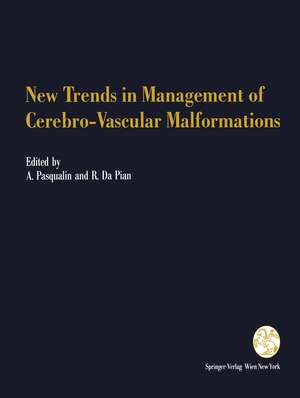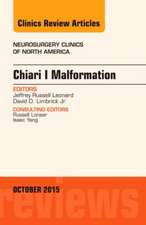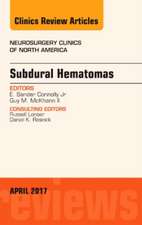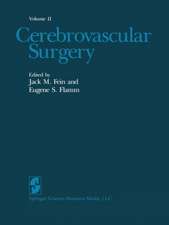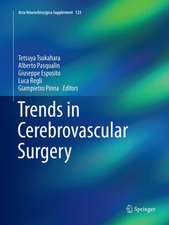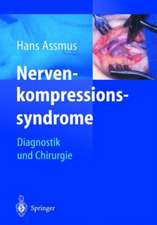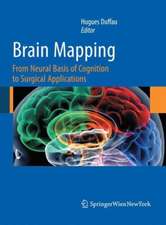New Trends in Management of Cerebro-Vascular Malformations: Proceedings of the International Conference Verona, Italy, June 8–12, 1992
R. Scienza Editat de Alberto Pasqualin, Renato Da Pianen Limba Engleză Paperback – 11 feb 2012
Preț: 405.86 lei
Preț vechi: 427.21 lei
-5% Nou
Puncte Express: 609
Preț estimativ în valută:
77.69€ • 84.41$ • 65.30£
77.69€ • 84.41$ • 65.30£
Carte tipărită la comandă
Livrare economică 21 aprilie-05 mai
Preluare comenzi: 021 569.72.76
Specificații
ISBN-13: 9783709193327
ISBN-10: 370919332X
Pagini: 604
Ilustrații: XIV, 582 p.
Dimensiuni: 210 x 279 x 32 mm
Greutate: 1.34 kg
Ediția:Softcover reprint of the original 1st ed. 1994
Editura: SPRINGER VIENNA
Colecția Springer
Locul publicării:Vienna, Austria
ISBN-10: 370919332X
Pagini: 604
Ilustrații: XIV, 582 p.
Dimensiuni: 210 x 279 x 32 mm
Greutate: 1.34 kg
Ediția:Softcover reprint of the original 1st ed. 1994
Editura: SPRINGER VIENNA
Colecția Springer
Locul publicării:Vienna, Austria
Public țintă
ResearchDescriere
Every so often a gathering of minds and experience occurs that results in an all encompassing overview in depth of such a vast subject as Cerebro-Vascular Malformations, as occurred in Verona in June 1992 and which warrants publication. Professors Da Pian and Pasqualin deserve high compliment and it is a measure of the respect in which they are held that virtually all those most knowledgeable around the world attended, presented their work and thoughts and contributed to intense discussion. Ljunggren's opening historical survey set the stage and must be the most comprehensive yet published. Subarachnoid hemorrhage from aneurysm rupture still constitutes, I dare say, the most difficult problem for neurosurgeons, in relief of the brain injury and arterial reaction and the technical perfection of aneurysm obliteration, even for small, as well as large and giant sacs. Very large high flow A VMs can be as demanding too. The bulk of the conference was devoted to subarachnoid hemorrhage, aneurysms and A VMs which were discussed under about 14 headings each. But vein of Galen malformations, dural A VMs, cavernous angiomas and venous angiomas (renamed developmental venous anomalies) came under scrutiny, not always with consensus. Trends are perceptible such as fibrinolysis of subarachnoid clot, non surgery for Galenic and dural malforma tions, the benignity of venous angioma, but there is still much variation in approach, pharmacologically, technically and with such as the evolving endovascular and radiosurgical stories, used alone or in conjunction.
Cuprins
History and Epidemiology of SAH and Cerebrovascular Malformations.- Clinical Usefulness of Magnetic Resonance Angiography in Neurosurgical Practice.- Intracranial Aneurysms and Subarachnoid Hemorrhage.- Research in Cerebral Vasospasm.- New Evidence Pointing to Oxyhemoglobin as the Cause of Vasospasm.- Recent Advances in Research of Cerebral Vasospasm — Possible Participation of Endothelin in the Genesis of Vasospasm.- Cerebral Blood Flow in Middle Cerebral Ischaemia is Increased by Calcitonin Gene-Related Peptide.- Anticoagulation Factors, Protein C, Protein S, and Antithrombin III in Subarachnoid Haemorrhage Patients.- A Study on Cisternal CSF Levels of Endothelin-1 After Subarachnoid Haemorrhage.- Early Blood-Brain Barrier Changes After Experimental Subarachnoid Haemorrhage: a Quantitative and Electron Microscopy Study.- Prevention of Experimental Vasospasm with Intermittent Intracistemal rtPA.- Cerebral Hemodynamics After SAH.- Cerebral Blood Flow Assessment Following Subarachnoid Hemorrhage.- Haemodynamic Evaluation of Cerebral Perfusion After Subarachnoid Haemorrhage — a Review.- Transcranial Doppler Evaluation of Cerebral Perfusion After SAH.- Combined Transcranial Doppler Sonography and rCBF Measurements in the Early Stage of Subarachnoid Hemorrhage.- Pharmacological Treatment of Vasospasm.- Principles of Pharmaceutical Therapy for Vasospasm Following Subarachnoid Hemorrhage.- A Calcium Antagonist in Aneurysmal SAH.- Nimodipine and Cerebral Vasospasm: Review of Effects and Mechanisms.- Tirilazad and Aneurysmal Subarachnoid Hemorrhage.- Effect of Calcitonin Gene-Related Peptide on Outcome of Ischaemic Deficits After Subarachnoid Haemorrhage.- Clinical Effects of Nimodipine in Prevention of Vasospasm After Subarachnoid Hemorrhage.- Prevention of Cerebral Vasospasm — Cisternal Irrigation Therapy with Urokinase and Ascorbic Acid.- Intracisternal Recombinant Tissue Plasminogen Activator After Aneurysmal Subarachnoid Hemorrhage: Results of a Preliminary Study.- Intracisternal Therapy with Tissue Plasminogen Activator for the Prevention of Vasospasm in Patients with Aneursymal Subarachnoid Hemorrhage. A Review.- The Use of Dobutamine to Enhance Cardiac Performance and Improve Outcome in Patients Refractory to Hypervolemic Therapy for Cerebral Vasospasm: a Preliminary Study.- Single Intracisternal Injection of Recombinant Tissue Type Plasminogen Activator for Prevention of Cerebral Vasospasm.- Endovascular Approaches to Vasospasm.- Angioplasty of Cerebral Vasospasm.- Balloon Angioplasty for the Treatment of Symptomatic Vasospasm.- Intra-Arterial Papaverine for the Treatment of Cerebral Vasospasm.- Anesthesia and Temporary Clipping in Aneurysm Surgery.- Anesthesia in Aneurysm Surgery.- Special Anesthetic Considerations for Management of Cerebral Aneurysm Clipping.- Total Intravenous Anesthesia Using Propofol for Burst Suppression in Cerebral Aneurysm Surgery: Preliminary Report of 44 Cases.- Temporary Clipping in Aneurysm Surgery.- Limits of Temporary Arterial Occlusion.- Deep Hypothermic Circulatory Arrest as an Adjunct to Complex Intracranial Aneurysm Surgery.- Surgery of Giant Aneurysms.- Clipping Techniques for Partially Thrombosed Giant Aneurysms.- Complication Avoidance for Large and Giant Carotid Ophthalmic Aneurysms.- Direct Microsurgical Approach to Giant Intracranial Aneurysms. Considerations, Technical Notes and Results in a Series of 47 Cases.- Surgical Treatment of Large and Giant Carotid-Ophthalmic Artery Aneurysms.- Surgery of Posterior Circulation Aneurysms.- Vertebrobasilar Artery Aneurysms: Current Management Techniques.- The Transsylvian Approach to Basilar Aneurysms.- Transclinoid-Transsellar-Transcavernous Approach to Basilar Tip Aneurysms.- Combined Pterional-Subtemporal Approach to Upper Basilar Artery Aneurysms.- Early Surgery for Ruptured Aneurysms of the Posterior Circulation — 60 Consecutive Cases.- Retrolabyrinthine Trans-Sigmoid (RLTS) Approach to Aneurysms of the Basilar Trunk and Vertebrobasilar Junction: an Update.- An Anterior Approach to Aneurysms of the Vertebro-Basilar Junction.- Anterior Transpetrosal Approach for Basilar Trunk Aneurysms — Further Experience.- Endovascular Treatment of Aneurysms.- Standard and Giant Aneurysms: The Role of Endovascular Therapy.- Endovascular Treatment of Intracranial Saccular Aneurysms with GDC Platinum Detachable Coils: Small-Necked Aneurysms.- Internal Carotid Artery Balloon Test Occlusion Does Require Quantitative Assessment of CBF.- Endovascular Treatment of Giant Intracranial Aneurysms by Balloon Occlusion of the Parent Vessel: Clinical and Diagnostic Follow-up.- Severe Subarachnoid Hemorrhage, Unruptured and Intracavernous Aneurysms, Aneurysm Rests.- Acute Medical and Surgical Management of Severely Ill Aneurysm Patients: a Review.- Strategy of Surgical Treatment in Severely Ill Patients After Aneurysmal Subarachnoid Hemorrhage.- Unruptured Intracranial Aneurysms — Current Concepts and Future Directions.- Validity of Surgical Treatment of Unruptured Aneurysms.- The Fate of Patients with Incidental Intracavernous Carotid Artery Aneurysms (ICCAA).- Surgical and Endovascular Approaches to Intracavernous Aneurysms.- Aneurysm Rests in a Surgical Series of 275 (Five Years): Incidence, Prognostic and Therapeutic Implications.- Recurrent Subarachnoid Hemorrhage After Aneurysm Surgery.- Intracranial Arteriovenous Malformations.- Classification of Cerebral AVMs.- Classification of Arteriovenous Malformations.- A New Grading System for Cerebral Arteriovenous Malformations.- Use of the Callosal Grid System for Cortical Localization.- Hemodynamics of Cerebral AVMs and Perioperative Management.- Hemodynamics of Cerebral Angiomas: Perioperative Angiography, Transcranial and Intraoperative Doppler Studies.- Cerebrovascular Reserve Capacity in AVM Patients.- Vasodilatory Challenge with rCBF Measurement in Patients with Cerebral AVMs: a Preliminary Report.- Clinical Evaluation of Cerebral Perfusion in AVM Patients.- The Role of Hemodynamic Assessment in Patients with Cerebral AVMs.- Selective Flow Modulation of Proximal Feeding Arteries in Surgery of High-Flow Cerebral Arteriovenous Malformations.- The Importance of Transcranial Doppler Sonography in the Management of Cerebral AVMs: Pre-Treatment Evaluation and Post-Embolization Changes.- Perioperative Management of High-Flow Arteriovenous Malformations; Hemodynamic Monitoring and Anesthetic Considerations.- Deep Barbiturate Anesthesia in the Multi-Staged Treatment of Large Deep AVMs.- Surgery of Deep-Seated and Posterior Fossa AVMs.- Medial Hemisphere and Tentorial Ring AVMs.- Surgical Experience with CallosalCingular and Inferior Limbic AVMs.- Stereotactic Uses in the Treatment of Deep “Inaccessible” AVMs and a Comparison with Radiosurgery.- Surgical Removal of Thalamic Arteriovenous Malformation — Transventricular Approach, Sitting Position, Intraoperative Angiography.- Treatment of Deep Basal Cerebral Arteriovenous Malformations.- The Surgery of Posterior Fossa Arteriovenous Malformations.- Surgical Experience with Cerebellar AVMs.- Embolization of Cerebral AVMs.- Overview of Embolic Materials and Clinical Use of EVAL.- Use of Ethanol in Preoperative AVM Embolization.- Embolization of Cerebral AVMs with Polylene Threads: Technical Procedure, Results and Complications.- Transcranial Doppler Sonography After Embolization and Staged Operation of AVMs and Balloon Occlusion of Carotid-Cavernous Sinus Fistula.- Radiosurgery of Cerebral AVMs.- Gamma Knife Radiosurgery in Cerebral Vascular Malformations.- Combined Treatments for Cerebral AVMs.- The Role of Embolization in the Surgical Resection of AVMs.- Further Experience in the Treatment of Cerebral Arteriovenous Malformations with Embolization Plus Surgery.- The Team Approach to Combined Embolization and Resection of Arteriovenous Malformations.- Staged Occlusion of Arteriovenous Malformations.- Outcome from Multimodality, Treatment of Arteriovenous Malformations.- Therapeutic Strategies for Brain AVMs. An Assessment of Benefits and Risks of Surgical and Endovascular Therapy.- Management of Critical Cavernous Malformations.- Cavernous Malformations of the Brain Stem.- Cavernomas of the Basal Ganglia, Brain Stem and Spinal Cord. Surgical Strategy and Results.- Sellar and Parasellar Extra-Axial Cavernous Hemangiomas.- Intracranial Cavernous Angiomas: a Simple Method for Their Surgical Approach.- Auditory Evoked Responses and Blink Reflex in Brain-Stem Cavernous Angiomas. Report of 7 Cases.- Management of Vein of Galen Malformations, Dural AVMs, Venous Angiomas.- Endovascular Management of Vein of Galen Malformations.
